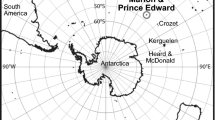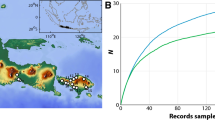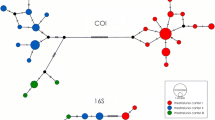Abstract
Red algae are frequently dominant components of the non-native biotas in coastal areas. They often remain undetected because of morphological similarity between native and introduced species and cryptic diversity. Routine use of DNA barcodes can aid in setting baseline tabulations of native species and for detecting introduced species. We performed an extensive survey of the red algal family Rhodomelaceae in southern Australia, producing a dataset containing more than 1100 rbcL sequences. The objective of this study was to screen that dataset for introduced species of the tribes Polysiphoniaeae and Streblocladieae, and to provide morphological information of presumably introduced species that were not previously recorded in Australia. Molecular data and morphological observations confirmed the presence of five presumably introduced species: Leptosiphonia brodiei, Melanothamnus japonicus, M. strictissimus, Polysiphonia morrowii and P. delicata. Polysiphonia morrowii and M. strictissimus were detected for the first time in Australia, and M. japonicus and P. delicata were found to be more widely distributed than previously known. Somewhat unexpectedly, the distribution range of L. brodiei has apparently shrunk, with our survey suggesting it remains only in Tasmania. Four of these species have been reported as introduced species in other countries, but M. strictissimus is here recorded for the first time outside its native New Zealand. Although all five species can be considered introduced or cryptogenic, only P. morrowii, M. japonicus and M. strictissimus were locally abundant, and further work will be needed to assess their ability to spread and effect negative impacts on native biotas.






Similar content being viewed by others
References
Adams NM (1991) The New Zealand species of Polysiphonia Greville. N Z J Bot 29:411–427
Arenas F, Bishop JDD, Carlton JT, Dyrynda PJ, Farnham WF, González DJ, Jacobs MW, Lambert C, Lambert G, Nielsen SE, Pederson JA, Porter JS, Ward S, Wood CA (2006) Alien species and other notable records from a rapid assessment survey of marinas on the south coast of England. J Mar Biol Assoc UK 86:1329–1337
Carlton JT, Geller JT (1993) Ecological roulette: the global transport of nonindigenous marine organisms. Science 261:78–82
Casas G, Scrosati R, Luz Piriz M (2004) The invasive kelp Undaria pinnatifida (Phaeophyceae, Laminariales) reduces native seaweed diversity in Nuevo gulf (Patagonia, Argentina). Biol Invasions 6:411–416
Croce ME, Parodi ER (2014) The Japanese alga Polysiphonia morrowii (Rhodomelaceae, Rhodophyta) on the South Atlantic Ocean: first report of an invasive macroalga inhabiting oyster reefs. Helgol Mar Res 68:241–252
Curiel D, Bellemo G, La Rocca B, Scattolin M, Marzocchi M (2002) First report of Polysiphonia morrowii Harvey (Ceramiales, Rhodophyta) in the Mediterranean Sea. Bot Mar 45:66–70
D'Archino R, Neill KF, Nelson WA (2013) Recognition and distribution of Polysiphonia morrowii (Rhodomelaceae, Rhodophyta) in New Zealand. Bot Mar 56:41–47
Díaz-Tapia P, Kim MS, Secilla A, Bárbara I, Cremades J (2013) Taxonomic reassessment of Polysiphonia foetidissima (Rhodomelaceae, Rhodophyta) and similar species, including P. schneideri, a new introduced species in Europe. Eur J Phycol 48:345–362
Díaz-Tapia P, Bárbara I, Cremades J, Verbruggen H, Maggs CA (2017a) Three new cryptogenic species in the tribes Polysiphonieae and Streblocladieae (Rhodomelaceae, Rhodophyta). Phycologia 56:605–623
Díaz-Tapia P, Maggs CA, West JA, Verbruggen H (2017b) Analysis of chloroplast genomes and a supermatrix inform reclassification of the Rhodomelaceae (Rhodophyta). J Phycol 53:920–937
Díaz-Tapia P, Maggs CA, Macaya EC, Verbruggen H (2018) Widely distributed red algae often represent hidden introductions, complexes of cryptic species or species with strong phylogeographic structure. J Phycol 54:829–839
Díaz-Tapia P, Maggs CA, Nelson W, Macaya EC, Verbruggen H (2019) Reassessment of the genus Lophurella (Rhodomelaceae, Rhodophyta) from Australia and New Zealand reveals four cryptic species. Eur J Phycol in press
Epstein G, Smale DA (2017) Undaria pinnatifida: a case study to highlight challenges in marine invasion ecology and management. Ecol Evol 7:8624–8642
Foster SD, Griffin DA, Dunstan PK (2014) Twenty years of high-resolution sea surface temperature imagery around Australia: inter-annual and annual variability. PLoS One 9:e100762
Geoffroy A, Le Gall L, Destombe C (2012) Cryptic introduction of the red alga Polysiphonia morrowii Harvey (Rhodomelaceae, Rhodophyta) in the North Atlantic Ocean highlighted by a DNA barcoding approach. Aquat Bot 100:67–71
Geoffroy A, Destombe C, Kim B, Mauger S, Raffo MP, Kim MS, Le Gall L (2016) Patterns of genetic diversity of the cryptogenic red alga Polysiphonia morrowii (Ceramiales, Rhodophyta) suggest multiple origins of the Atlantic populations. Ecol Evol 6:5635–5647
Gregory LP, Campbell ML, Primo C, Hewitt CL (2012) Biotic and abiotic factors affecting the Tasmanian distribution and density of the introduced New Zealand porcelain crab Petrolisthes elongatus. Aquat Invasions 7:491–501
Guiry MD, Guiry GM (2019) AlgaeBase. World-wide electronic publication, National University of Ireland, Galway. https://www.algaebase.org; searched on 7 June 2019.
Hardin G (1960) The competitive exclusion principle. Science 131:1292–1297
Hayes K, Sliwa C, Migus S, McEnnulty F, Dunstan P (2005) National priority pests: part II ranking of Australian marine pests. An independent report undertaken for the Department of Environment and Heritage by CSIRO Marine Research.
Hewitt CL, Campbell ML (2007) Mechanisms for the prevention of marine bioinvasions for better biosecurity. Mar Pollut Bull 55:395–401
Huisman JM (2018) Algae of Australia. Marine benthic algae of north-western Australia. 2. Red algae. ABRS and CSIRO Publishing, Canberra and Melbourne. 672 pp.
Hutchings P (2013) Why are taxonomists often regarded as second class citizens? A misclassification that threatens the basic infrastructure of biodiversity. In: Lunney D, Hutchings P, Recher H (eds) Grumpy scientists. Royal Zoological Society of New South Wales, Mosman, pp 26–30
Hutchings P (2018) Marine introduced species in Australia, where to from here? A personal perspective from a practising taxonomist. Mar Pollut Bull 136:477–480
Kearse M, Moir R, Wilson A, Stones-Havas S, Cheung M, Sturrock S, Buxton S, Cooper A, Markowitz S, Duran C, Thierer T, Ashton B, Meintjes P, Drummond A (2012) Geneious Basic: an integrated and extendable desktop software platform for the organization and analysis of sequence data. Bioinformatics 28:1647–1649
Kim M-S, Yang EC, Mansilla A, Boo SM (2004) Recent introduction of Polysiphonia morrowii (Ceramiales, Rhodophyta) to Punta Arenas, Chile. Bot Mar 47:389–394
Krueger-Hadfield SA, Kollars NM, Strand AE, Byers JE, Shainker SJ, Terada R, Greig TW, Hammann M, Murray DC, Weinberger F, Sotka EE (2016) The identification of source and vector of a prolific marine invader. Ecol Evol 7:4432–4447
Lohrer AM, Whitlatch RB (2002) Interactions among aliens: apparent replacement of one exotic species by another. Ecology 83:719–732
Manghisi A, Miladi R, Armeli Minicante S, Genovese G, Le Gall L, Abdelkafi S, Saunders GW, Morabito M (2019) DNA barcoding sheds light on novel records in the Tunisian red algal flora. Cryptogam Algol 40:5–27
Maggs CA, Hommersand M (1993) Seaweeds of the British Isles. Volume 1. Rhodophyta. Part 3A. Ceramiales. HMSO, London. pp. 444.
Maggs CA, Stegenga H (1998) Red algal exotics on North Sea coasts. Helgol Meeresunters 52:243–258
McIvor L, Maggs CA, Provan J, Stanhope MJ (2001) rbcL sequences reveal multiple cryptic introductions of the Japanese red alga Polysiphonia harveyi. Mol Ecol 10:911–919
Meynard A, Zapata J, Salas N, Betancourtt C, Pérez‐Lara G, Castañeda F, Ramírez ME, Contador CB, Guillemin M-L, Contreras‐Porcia L, Müller K (2019) Genetic and morphological differentiation of and species (Bangiales, Rhodophyta) coexisting in a rocky intertidal in Central Chile . J Phycol 55 (2):297-313
Mineur F, Belsher T, Johnson MP, Maggs CA, Verlaque M (2007a) Experimental assessment of oyster transfers as a vector for macroalgal introductions. Biol Conserv 137:237–247
Mineur F, Johnson MP, Maggs CA (2008) Macroalgal introductions by hull fouling on recreational vessels: seaweeds and sailors. Environ Manag 42:667–676
Mineur F, Johnson MP, Maggs CA, Stegenga H (2007b) Hull fouling on commercial ships as a vector of macroalgal introduction. Mar Biol 151:1299–1307
Mineur F, Le Roux A, Maggs CA, Verlaque M (2014) Positive feedback loop between introductions of non-native marine species and cultivation of oysters in Europe. Conserv Biol 28:1667–1676
Molnar JL, Gamboa RL, Revenga C, Spalding MD (2008) Assessing the global threat of invasive species to marine biodiversity. Front Ecol Environ 6:485–492
Mobsby D, Koduah A (2017) Australian fisheries and aquaculture statistics 2016, Fisheries Research and Development Corporation project 2017-095. ABARES, Canberra
Nam KW, Kang PJ (2012) Algal flora of Korea. Volume 4, number 4. Rhodophyta: Ceramiales: Rhodomelaceae: 18 genera including Herposiphonia. National Institute of Biological Resources, Incheon, p 178
Nelson WA (1999) A revised checklist of marine algae naturalised in New Zealand. N Z J Bot 37:355–359
Nelson WA (2013) New Zealand seaweeds. An illustrated guide. Te Papa Press, Wellington, p 328
Nelson WA, Maggs CA (1996) Records of adventive marine algae in New Zealand: Antithamnionella ternifolia, Polysiphonia senticulosa (Ceramiales, Rhodophyta) and Striaria attenuata (Dictyosiphonales, Phaeophyta). N Z J Mar Freshwat Res 30:449–453
Oliveira MC, Repetti SI, Iha C, Jackson CJ, Diaz-Tapia P, Magalhaes K, Cassano V, Costa JF, MCM C, Marcelino VR, Verbruggen H (2018) High–throughput sequencing for algal systematics. Eur J Phycol 53:256–272
Ogburn DM (2007) Environmental impacts in Australian aquaculture. In: Bert TM (ed) Ecological and genetic implications of aquaculture activities. Springer, Dordrecht, pp 177–189
Saunders GW, McDevit DC (2012) Methods for DNA barcoding photosynthetic protists emphasizing the macroalgae and diatoms. In: Kress W, Erickson D (eds) DNA barcodes. Methods in molecular biology. Methods and protocols. Humana Press, Totowa, pp 207–222
Saunders GW, Moore TE (2013) Refinements for the amplification and sequencing of red algal DNA barcode and RedToL phylogenetic markers: a summary of current primers, profiles and strategies. Algae 28:31–43
Saunders GW, Huisman JM, Vergés A, Kraft GT, Le G (2017) Phylogenetic analyses support recognition of ten new genera, ten new species and 16 new combinations in the family Kallymeniaceae (Gigartinales, Rhodophyta). Cryptogam Algol 28:79–132
Savoie AM, Saunders GW (2015) Evidence for the introduction of the Asian red alga Neosiphonia japonica and its introgression with Neosiphonia harveyi (Ceramiales, Rhodophyta) in the Northwest Atlantic. Mol Ecol 24:5927–2937
Savoie AM, Saunders GW (2016) A molecular phylogenetic and DNA barcode assessment of the tribe Pterosiphonieae (Ceramiales, Rhodophyta) emphasizing the Northeast Pacific. Botany 94:917–939
Savoie AM, Saunders GW (2019) A molecular assessment of species diversity and generic boundaries in the red algal tribes Polysiphonieae and Streblocladieae (Rhodomelaceae, Rhodophyta) in Canada. Eur J Phycol 54:1–25
Scheibling RE, Gagnon P (2006) Competitive interactions between the invasive green alga Codium fragile ssp tomentosoides and native canopy-forming seaweeds in Nova Scotia (Canada). Mar Ecol Prog Ser 325:1–14
Stamatakis A (2014) RAxML version 8: a tool for phylogenetic analysis and post-analysis of large phylogenies. Bioinformatics 30:1312–1313
Steen F, Aragay J, Zuljevic A, Verbruggen H, Mancuso FP, Bunker F, Vitales D, Gómez Garreta A, De Clerck O (2017) Tracing the introduction history of the brown seaweed Dictyota cyanoloma (Phaeophyceae, Dictyotales) in Europe. Eur J Phycol 52:31–42
Thomsen MS, Wernberg T, South PM, Schiel DR (2016) Non-native seaweeds drive changes in marine coastal communities around the world. In: Hu Z-M, Fraser C (eds) Seaweed phylogeography: adaptation and evolution of seaweeds under environmental change. Springer, Dordrecht, pp 147–185
Verbruggen H, Brookes MJL, Costa JF (2017) DNA barcodes and morphometric data indicate that Codium fragile (Bryopsidales, Chlorophyta) may consist of two species. Phycologia 56:54–62
Williams SL, Smith JE (2007) A global review of the distribution, taxonomy, and impacts of introduced seaweeds. Annu Rev Ecol Evol Syst 38:327–359
Wolf MA, Buosi A, Juhmani A-SF, Sfriso A (2018) Shellfish import and hull fouling as vectors for new red algal introductions in the Venice lagoon. Estuar Coast Shelf Sci 215:30–38
Womersley HBS (1979) Southern Australian species of Polysiphonia Greville (Rhodophyta). Aust J Bot 27:459–528
Womersley HBS (1990) Biogeography of Australasian marine macroalgae. In: Clayton MN, King RJ (eds) Biology of marine plants. Longman, Melbourne, pp 367–381
Womersley HBS (1994) The marine benthic flora of southern Australia - part IIIA Bangiophyceae and Florideophyceae (Acrochaetiales, Nemaliales, Gelidiales, Hildenbrandiales and Gigartinales sensu lato). Australian Biological Resources Study and State Herbarium of South Australia, Canberra and Adelaide. pp. 508
Womersley HBS (1996) The marine benthic flora of southern Australia - part IIIB Gracilariales, Rhodymeniales, Corallinales and Bonnemaisoniales. Australian Biological Resources Study and State Herbarium of South Australia, Canberra and Adelaide. pp. 392
Womersley HBS (1998) The marine benthic flora of southern Australia - part IIIC Ceramiales - Ceramiaceae, Dasyaceae. Australian Biological Resources Study and State Herbarium of South Australia, Canberra and Adelaide. pp. 535
Womersley HBS (2003) The marine benthic flora of southern Australia - part IIID Ceramiales - Delesseriaceae, Sarcomeniaceae, Rhodomelaceae. Australian Biological Resources Study and State Herbarium of South Australia, Canberra and Adelaide. pp. 533
Zuccarello GC, West J, Rueness J (2002) Phylogeography of the cosmopolitan red alga Caulacanthus ustulatus (Caulacanthaceae, Gigartinales). Phycol Res 50:163–172
Acknowledgements
We thank Joana Costa, Kyatt Dixon, Margaret Brookes and Guadalupe Bribiesca-Contreras and the Parks Victoria and Bush Blitz teams for assistance in the field.
Funding
P.D.T. acknowledges support from the postdoctoral program “Axudas de apoio á etapa de formación posdoutoral, Xunta de Galicia” (ED481D2017/011). C.P.C. and P.D.T. received funding from Xunta de Galicia within the program “Axudas para a consolidación e estruturación de unidades de investigación competitivas do SUG” (grants GPC2015/025, ED431D 2017/20, ED431B 2018/49). Funding for the field and molecular work in eastern Victoria, including participation in a Bush Blitz expedition, a Bush Blitz Strategic Taxonomy Grant (TTC216-03) and a National Taxonomy Research Grant (RFL213-08), was provided by the Australian Biological Resources Study. Sampling in Western Australia and Tasmania was made possible through funding from the Holsworth Wildlife Research Endowment.
Author information
Authors and Affiliations
Corresponding author
Additional information
Publisher’s note
Springer Nature remains neutral with regard to jurisdictional claims in published maps and institutional affiliations.
Electronic supplementary material
ESM 1
(PDF 186 kb)
Rights and permissions
About this article
Cite this article
Piñeiro-Corbeira, C., Verbruggen, H. & Díaz-Tapia, P. Molecular survey of the red algal family Rhodomelaceae (Ceramiales, Rhodophyta) in Australia reveals new introduced species. J Appl Phycol 32, 2535–2547 (2020). https://doi.org/10.1007/s10811-019-01932-4
Received:
Revised:
Accepted:
Published:
Issue Date:
DOI: https://doi.org/10.1007/s10811-019-01932-4




